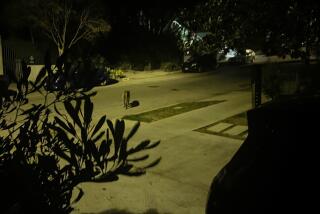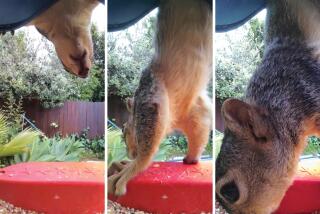Fed Up : Food Handouts to Foxes Threaten the Balance of Torrance Preserve
- Share via
Amid the reeds and foxtails of Madrona Marsh, the red fox, ears erect, stood frozen, peering for a few seconds at the human intruders who had disturbed its solitary twilight search for supper.
Then with a quick pivot, it vanished into the underbrush, leaving a stunning afterimage of untamed grace.
But if the fox could easily evade a casual visitor, environmentalists believe it and its kin are having more trouble avoiding well-meaning people who threaten the ecological balance by feeding the foxes. The result is that the fox population in Torrance’s 50-acre Madrona Marsh is on the increase, and they are decimating the natural prey.
Offerings of Pet Food
“We love our foxes, (but) it is in their own best interest that we allow them to fend for themselves,” said Martin Byhower. He is vice president of Torrance’s Friends of Madrona Marsh, a group that wants to keep the marsh in a natural state.
He said some people have been leaving pet food near the marsh. Others have left gophers they have trapped--some of them alive, some freshly killed.
One of the chief culprits turned out to be Torrance’s Department of Parks and Recreation, operating on the assumption that the Friends group wanted more food for the foxes, according to department Director Gene Barnett.
The department’s gopher trapper, Hank Barnowski, “renowned in our department for his ability to wipe out gopher populations . . . has been transporting some of these critters over to the marsh under the assumption--and maybe a false assumption--that he had been requested to do so by well-meaning members of the Friends,” Barnett said.
“We got the impression that the foxes were looking for some supplement to their diet. We thought, we got these gophers, maybe we can solve one problem with another. . . . We can certainly cease and desist,” he added.
Barnett said between 50 and 100 gophers had been left at the marsh.
In addition, plates of cat food have been left beside a hole in a fence that surrounds a sump across the street from the marsh, said Torrance firefighter Chris Johnson. “Somebody had been leaving stuff for the foxes,” Johnson said.
Byhower said: “Unfortunately, this seems to be causing an increase in population of foxes, which in turn seem to be becoming even more dependent on handouts.”
In addition, construction in the adjacent Park Del Amo development has eliminated land that formerly was fertile gopher hunting grounds for the foxes, forcing them to forage only in the marsh.
The result appears to be increased pressure on the foxes’ prey.
Once-plentiful rabbits have vanished from the marsh, Byhower said. “No opossums have been seen for quite a while.” Ground squirrels are going. Even skunks are fewer.
Likely Suspects
The likely suspects, according to Byhower, is a family of six red foxes--larger than the typical one--which lives in a burrow on the marsh property. He said no one has tried to track the fox population before this year.
The two parent foxes typically produce an annual litter of two kits, according to Shirley Turner, a board member of the Friends of Madrona Marsh, and the young leave after one year. However, Turner said the current family configuration appears to include two litters.
Jim Love of the Santa Fe Energy Co. sees them almost every day. “I have been watching (the foxes) for five years,” he said.
Over the years, cars have killed several of the kits before they matured, Love said.
Love, whose job involves monitoring an oil pumping station in the marsh, says the foxes are most likely to be spotted at dawn or dusk. They have grown so used to him that they ignore him if he stays behind the chain-link fence that guards the pumping station.
Much of the ground at the marsh site is pocked with gopher holes, and Love has seen the foxes catch the wary rodents.
“They stand over a gopher hole. They wait. They jump straight up in the air and down when they pounce,” he said. “It’s a trip.”
During the rainy season, when standing water covers the low-lying portions of the marsh, the foxes add frogs to their diet, Love said.
Recently, he said, two of the young foxes attacked a skunk that had ventured onto Maple Avenue, which forms the eastern boundary of the marsh, and the rest of the foxes soon joined in.
“All six of them were throwing the skunk all over the road. You couldn’t down the road for two days,” he said.
Appear Healthy
Although the foxes sighted in the marsh appear healthy, sooner or later, Byhower warns, they will run out of natural prey and be unable to sustain health on handouts.
The normal range for a red fox varies between 25 and 5,000 acres, according to Mike Crotty, mammals curator at the Los Angeles Zoo.
Madrona Marsh, which covers 46 acres, appears to be well below the necessary acreage for six foxes, which would be 150 acres, according to Crotty.
“Abnormally high fox populations become increasingly susceptible to disease,” Byhower said.






